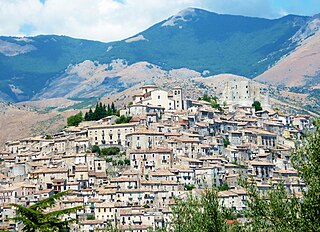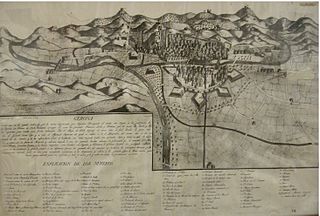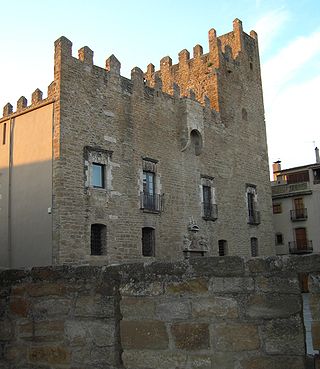
The two battles of the Bruch were engagements fought successively, at El Bruc, near Barcelona, Catalonia, on 6 and 14 June 1808, during the Peninsular War, by French troops commanded by Brigadier General François de Schwarz and General of Division Joseph Chabran against Spanish volunteers and mercenaries led by General Antoni Franch i Estalella and Joan Baget.

The third siege of Girona occurred in northern Catalonia, Spain from 6 May to 12 December 1809, during the Napoleonic Wars. A significant event of the Peninsular War, France's Grande Armée lay siege to the town of Girona for seven months. Girona was strategically important because it controlled the main road between France and Spain.

The Battle of Campo Tenese saw two divisions of the Imperial French Army of Naples led by Jean Reynier attack the left wing of the Royal Neapolitan Army under Roger de Damas. Though the defenders were protected by field fortifications, a French frontal attack combined with a turning movement rapidly overran the position and routed the Neapolitans with heavy losses. The action occurred at Campotenese, a little mountain village in the municipality of Morano Calabro in the north of Calabria. The battle was fought during the War of the Third Coalition, part of the Napoleonic Wars.

The blockade of Barcelona, from August to December 1808, was the failed attempt by Spanish troops to recapture the French occupied Barcelona during the Peninsular War.

François Xavier de Schwarz or François-Xavier-Nicolas Schwartz was born in Baden but joined the French army in 1776. He became a cavalry officer during the French Revolutionary Wars, fighting with the 2nd Hussar Regiment in numerous actions including Jemappes, Fleurus, and Neuwied. After being captured in an abortive invasion of Ireland, he was promoted to command the 5th Hussar Regiment. He led the unit in the War of the Second Coalition, most notably at Hohenlinden and in the subsequent pursuit of the Austrians.

The Battle of Castellón was an ambush delivered against a French Imperial detachment under General Reille near Girona during the Peninsular War (1807–14).
The Army of Naples was a French Army unit which took this name following its capture of Naples in 1799. It was related to the Army of Italy. The Army of Naples was virtually annihilated after the Battle of the Trebbia: more than half of the personnel were casualties.

The siege of Valencia from 3 November 1811 to 9 January 1812, saw Marshal Louis Gabriel Suchet's French Army of Aragon besiege Captain General Joaquín Blake y Joyes's forces in the city of Valencia, Spain, during the Peninsular War. The 20,000 to 30,000 French troops compelled 16,000 Spanish soldiers to surrender at the conclusion of the siege, although another 7,000 Spaniards escaped from the trap. Suchet quickly converted Valencia into an important base of operations after this Napoleonic Wars action. Valencia, modern-day capital of the Valencian Community, is located on the east coast of Spain.

The Battle of Cardadeu on 16 December 1808 saw an Imperial French corps led by Laurent Gouvion Saint-Cyr assault a Spanish force commanded by Juan Miguel de Vives y Feliu and Theodor von Reding. Saint-Cyr won the engagement by forming most of his troops into gigantic attack columns and smashing through the Spanish lines. Cardedeu is located 17 kilometres (11 mi) northeast of Barcelona, Spain. The action occurred during the Peninsular War, part of the Napoleonic Wars.

The second siege of Girona was the second unsuccessful French attempt to capture the city of Girona during the Peninsular War, part of the Napoleonic Wars.

The siege of Roses or siege of Rosas from 7 November to 5 December 1808 saw an Imperial French corps led by Laurent Gouvion Saint-Cyr invest a Catalan and Spanish garrison commanded by Peter O'Daly. After a siege lasting a month in which the haven and town of Roses was captured and the nearby Trinity Castle invested by over 13,000 French and Italian infantry, artillery and cavalry with heavy siege trains on the hills above, the citadel was surrendered to the Napoleonic forces. Roses (Rosas) is located 43 kilometres (27 mi) northeast of Girona, Catalonia, Spain. The action occurred during the Peninsular War, part of the Napoleonic Wars.

The Battle of Molins de Rei or Battle of Molins de Rey or Battle of Molins del Rey saw an Imperial French corps led by Laurent Gouvion Saint-Cyr attack a Spanish army temporarily led by Theodor von Reding and the Conde de Caldagues because its commander Juan Miguel de Vives y Feliu was absent. Saint-Cyr outmaneuvered his opponents, distracting them with a false attack in front while sending the bulk of his force across Llobregat River in a turning movement around the Spanish right flank. The Spanish defensive lines crumbled and the French captured 1,200 soldiers, all the Spanish artillery and Caldagues himself. The Peninsular War engagement was fought near Molins de Rei, located 15 kilometres (9 mi) west of Barcelona, Catalonia, Spain.

In the Battle of La Bisbal on 14 September 1810 a Spanish division led by Henry O'Donnell and supported by an Anglo-Spanish naval squadron led by Francis William Fane and Charles William Doyle surprised an Imperial French brigade commanded by François Xavier de Schwarz. The Imperial troops were from the Confederation of the Rhine, a collection of small German states that were allied to Napoleon. Part of a division led by Marie François Rouyer, Schwarz's brigade was almost completely wiped out, most of its soldiers being taken prisoner along with its commander. One of the few Allied casualties was the capable O'Donnell, wounded in the foot. The battle occurred during the Peninsular War, part of the Napoleonic Wars.

The siege of Figueras, which lasted from 10 April to 19 August 1811, saw the Spanish garrison of Sant Ferran Castle led by Brigadier General Juan Antonio Martínez defend against an Imperial French force commanded by Marshal Jacques MacDonald and his deputy Louis Baraguey d'Hilliers. Martínez and his men held out much longer than expected but were eventually starved into surrendering the fortress, which was near Figueres. The action occurred during the Peninsular War, part of the Napoleonic Wars.

The Battle of Manresa and Battle of Vilafranca from 21 March to 5 April 1810 saw a Spanish division led by Juan Caro and Luis González Torres de Navarra, Marquess of Campoverde attack an Imperial French brigade commanded by François Xavier de Schwarz.
The Battle of Sant Esteve d'en Bas took place on 10 March 1695 in the Catalan front of the War of the Grand Alliance. It was fought between a column of French regular infantry under Brigadier Urbain Le Clerc de Juigné, governor of the nearby French-occupied Castellfollit de la Roca, and 16 companies of Catalan miquelets and several armed peasants at the orders of Ramon de Sala i Saçala, the veguer of the town of Vic. Juigné's force was in a punitive expedition to burn the village of Sant Esteve d'en Bas, whose inhabitants had refused to pay war contributions to the French army, when it was attacked by the Catalan militia and nearly destroyed in two separate engagements.

Giuseppe Federico Palombini or Joseph Friedrich von Palombini became an Italian division commander during the Napoleonic Wars. He joined the army of the Cispadane Republic in 1796 and fought at Faenza in 1797. He became commander of a dragoon regiment in 1798. He became commander of the Napoleone Dragoons, of the Cisalpine Republic army, in 1802. He fought as an ally of the French at Kolberg and Stralsund in 1807. He married the daughter of Jan Henryk Dąbrowski (Dombrowski) in 1806.

The Cardedeu order of battle lists the troops that fought in the Battle of Cardedeu and several other battles fought between June and December in the Spanish province of Catalonia during the Peninsular War. In February 1808, Imperial French forces treacherously seized Barcelona on 29 February and Sant Ferran Castle on 15 March as well as other fortresses in Spain. The Dos de Mayo Uprising broke out when the Spanish people found that Emperor Napoleon deposed the Spanish royal family and set up his brother Joseph Bonaparte as their new king. The 12,000 Imperial French soldiers under Guillaume Philibert Duhesme occupying Catalonia were beaten at the Battles of El Bruch and Gerona in June. Though Duhesme was reinforced by another French division, the Spanish defeated him at the Second Siege of Gerona in July and August. With Duhesme blockaded in Barcelona, Napoleon appointed Laurent Gouvion Saint-Cyr as commander of the VII Corps, added two good divisions and other troops to his force, and ordered him to relieve Barcelona. Saint-Cyr succeeded in this task, winning the battles of Roses, Cardedeu and Molins de Rei in December.

The Army of the Kingdom of Naples was the primary land defence and offence force of the Kingdom of Naples. It served alongside Napoleon’s Grande Armée in various campaigns and wars across Europe, until its final demise in the Neapolitan War of 1815. It was in service from 1806 to 1815, reborn from the Army of the Two Sicilies after the annexation of Naples. The Army was more known for the splendour of its uniforms rather than the achievements of its troops.

The 1st Regiment of the Line (King's Own) or (Italian: 1° Reggimento della Linea 'del Re') was a line infantry regiment of the Royal Army of Naples. The regiment was the first infantry regiment formed by the small kingdom, but by 1811 gained a reputation as an exemplary infantry regiment, and was reformed with the honorary title of "King's Own, or del Re". After the disastrous Neapolitan War, the regiment was disbanded, having never seen action outside of the Napoleonic Wars.



















